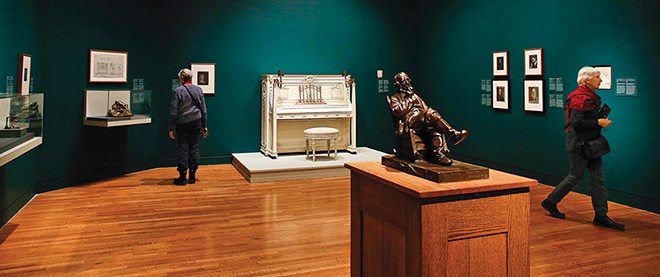The art era before the Group of Seven
An Expo 67 vibe—seven decades early
David Kawai
Share

When did art begin for real in Canada? For most Canadians, the Group of Seven’s rise in the 1920s is pretty much the start. Regular gallery-goers will of course know some of what came later. But before the Group? Hardly anything registers in the popular imagination. So the National Gallery of Canada’s current big show, Artists, Architects and Artisans: Canadian Art 1890-1918, takes on some heavy lifting by trying to persuade us to focus on a hazy earlier era.
If this is a history lesson, though, it’s not a tough slog. After all, the more than 300 objects curator Charles Hill gathers together—ranging from painting and sculpture, to weaving and stained glass—were designed in the first place to win over paying patrons. It’s easy to see why a Montreal financier shelled out for that elaborately carved upright piano in 1902, or why Birks approved those architect’s drawings—a pearl diver and a silversmith to be rendered in terracotta tile—for its Winnipeg store in 1914. But gaining a sense of why all these attractive things should be seen as connected is trickier.
Hill emphasizes the influences of the French beaux arts school, which put art at the service of architecture, and the English Arts and Crafts movement, which prized artisanship. More than tracing European inspirations, however, he sets out to capture the mood in Canada between the completion of the Canadian Pacific Railway in 1886 and the end of the First World War. “It’s an era of immense growth, an era of optimism,” Hill says. “It was also an era of reform—attempts to change how people saw their homes, their public spaces, their cities.”
He arranges the show almost as a series of mini-exhibitions on manifestations of that reforming spirit. One cluster of pieces deals with how like-minded artists and designers made common cause in Toronto. There’s Joseph-Ernest Sampson’s rather stiff painting of the crowded, fire-lit interior of the city’s important new Arts and Letters Club, and Wyly Grier’s more winning portrait of Mabel Cawthra, proudly seated with white roses at her feet and a black feather fan in hand. A driving force in the Arts and Crafts Society and the Woman’s Art Association of Canada, Cawthra looks the part. Original furniture she commissioned is in the show, and so are some pretty metal boxes, from around 1905, that she decorated herself after studying enamelling in England.
Of greater interest, though, are early efforts by artists who achieved lasting fame. Hill shows us future Group of Seven member Arthur Lismer’s gorgeous 1917 painting Georgian Bay, Spring and his design for a folding screen adapted from it—a vivid illustration of the show’s key theme about free interplay during the period between creating fine art and making functional objects. More often, the design work must hold our attention on its own merits or for what it tells us about the era. A metal-and-glass chandelier designed for Winnipeg’s Royal Alexandra Hotel, for instance, looks like just what a 1906 boom town needed. Some of the elaborate schemes for buildings and urban plans, represented by blueprints and drawings, suggest boundless ambition. Yet there were limits. It’s sad to learn that George Reid’s study for a mural meant for Parliament’s Centre Block was rejected in part over doubts that a Canadian artist could “undertake such important work.” On the other hand, it’s probably just as well the charismatic British city planner Thomas Mawson’s grand vision for Calgary, reconceived as a sort of Paris-on-the-Bow, didn’t fly.
Still, Mawson’s forgotten drawings, rediscovered in a Calgary garage in 1976, are more than just great fun. The broad avenues and monuments suggest an era when the line between possible and preposterous wasn’t clear. This show’s eclectic mix of lofty schemes, fresh architecture, high art cross-fertilizing with practical design—creates something like an Expo 67 vibe. What Hill manages to do with this exhibition, which is slated to run until Feb. 17, is make 1890-1918 feel, not like a prologue to the true story of Canadian culture, but an early flowering as vivid as anything that came after.